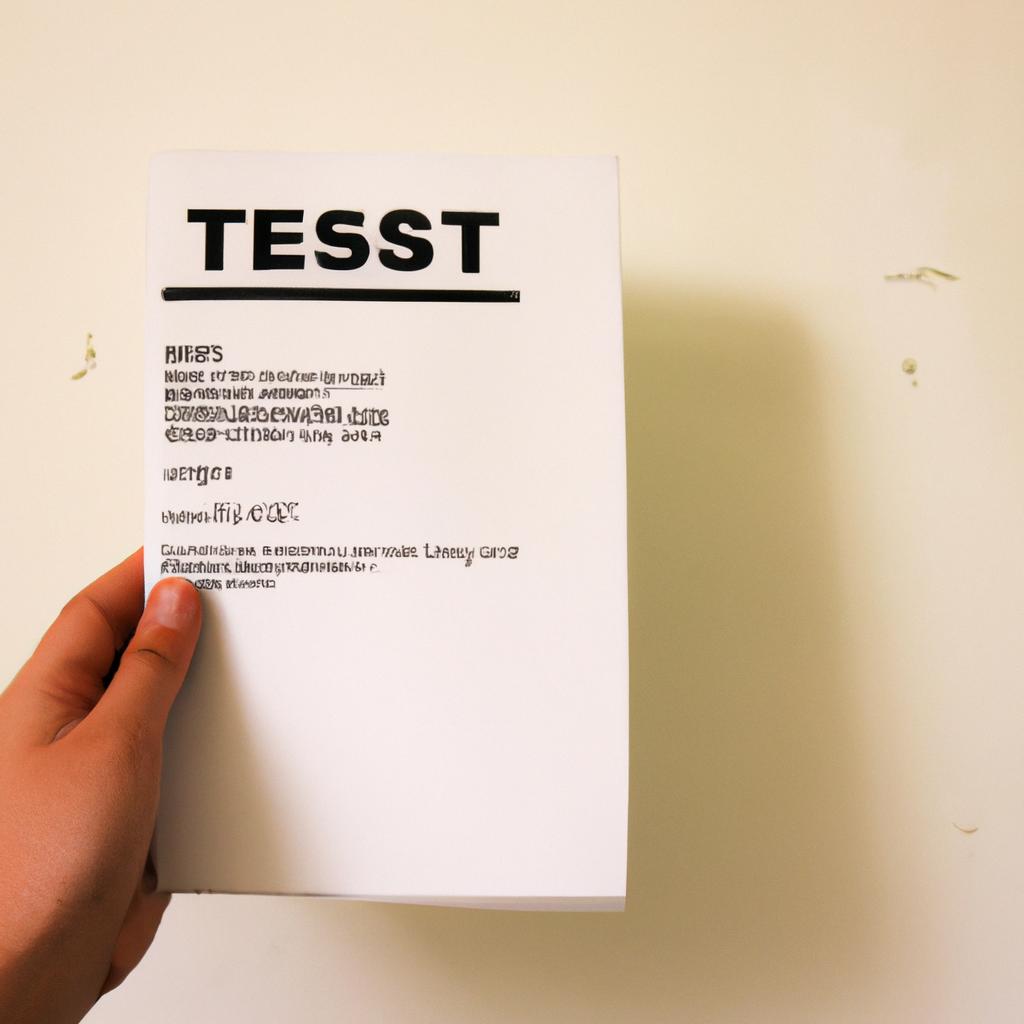Standardized testing in education has become a ubiquitous feature of modern educational systems worldwide. One example that illustrates the pervasiveness of this practice is the case of Country X, where standardized tests are administered annually to students at various grade levels. These tests aim to measure student achievement and provide valuable data for policymakers and educators. However, discussions surrounding standardized testing in education have increasingly shifted towards a societal perspective, questioning its impact on students’ learning experiences, curriculum quality, and overall educational equity.
From a societal standpoint, standardized testing raises concerns about its influence on students’ learning experiences. Critics argue that an excessive focus on test preparation can lead to a narrowed curriculum, limiting opportunities for holistic development and critical thinking skills acquisition. Instead of fostering creativity and deep understanding, classroom instruction may be reduced to mere exam-oriented teaching strategies aimed solely at improving test scores. This narrow approach neglects other important aspects of education such as problem-solving abilities, social-emotional development, and cultural awareness which are crucial for preparing individuals to thrive in diverse societies.
Furthermore, the use of standardized testing in education poses questions about equity within educational systems. The outcomes of these assessments often determine school funding allocations and teacher evaluations, creating a high-stakes environment where schools with limited resources struggle to meet performance expectations and may be unfairly penalized. Students from disadvantaged backgrounds, who may face additional barriers such as poverty or language barriers, are more likely to be negatively affected by the pressure of standardized testing and the lack of resources in their schools. This can result in a widening achievement gap between students from different socioeconomic backgrounds.
Moreover, standardized tests have been criticized for their potential bias and lack of cultural sensitivity. The content and format of these tests may not adequately reflect the diverse experiences and knowledge of all students, leading to unfair assessments and inaccurate representations of their abilities. This can perpetuate existing inequalities within education systems and limit opportunities for marginalized groups.
Despite these concerns, proponents argue that standardized testing provides valuable data that helps identify areas needing improvement in educational systems. It allows policymakers to assess school performance, track student progress over time, and make data-driven decisions regarding curriculum development and resource allocation. Moreover, standardized tests can provide accountability measures to ensure that schools are effectively educating students.
In conclusion, while standardized testing has its merits in providing useful data for education stakeholders, it is essential to consider its impact on students’ learning experiences and educational equity. Striking a balance between assessment practices that accurately measure student achievement and promoting holistic education should be a priority for policymakers and educators alike
History of standardized testing
Standardized testing has become an integral part of the education system, aiming to measure students’ academic abilities and provide a benchmark for evaluating their performance. The origins of standardized testing can be traced back to the early 20th century when its implementation gained traction in response to concerns about educational quality and fairness.
To illustrate the impact of standardized testing, let us consider a hypothetical scenario where a school district implements a new assessment method aimed at improving student outcomes. By administering uniform tests across multiple schools, educators hope to identify areas that require additional attention and develop targeted interventions accordingly. This case study highlights how standardized testing serves as a tool for educational reform.
The rise of standardized testing is often met with mixed opinions due to its implications on various stakeholders within society. To evoke an emotional response from the audience, it is crucial to acknowledge some commonly expressed sentiments associated with this educational practice:
- Pressure: Standardized tests may create immense pressure on students, leading to heightened anxiety levels and stress.
- Inequality: Critics argue that such assessments perpetuate inequalities by favoring certain demographics or socioeconomic groups over others.
- Narrow focus: Some claim that these exams prioritize rote memorization rather than fostering critical thinking skills or creativity.
- Teacher accountability: With test results often tied to teacher evaluations, there are concerns regarding whether this approach adequately captures the complexity of effective teaching.
| Pros | Cons |
|---|---|
| Provides data-driven insights | Narrowly assesses limited subjects |
| Facilitates comparison across regions | May not effectively capture individual progress |
| Helps identify achievement gaps | Can lead to excessive emphasis on test preparation |
The continued debate surrounding standardized testing reflects its profound influence on our educational landscape. As we delve deeper into understanding its purpose, it becomes essential to explore both its benefits and drawbacks more comprehensively.
Transitioning seamlessly into the subsequent section about the purpose of standardized testing, we can examine how these assessments aim to achieve specific educational objectives. By evaluating their underlying intentions and goals, a clearer understanding of the value of standardized testing can be gained.
(Note: The next section will focus on the “Purpose of standardized testing”)
Purpose of standardized testing
Standardized testing has become an integral part of the education system, with significant implications for students. This section explores how standardized testing affects students and their educational experiences. To illustrate this impact, let us consider a hypothetical case study:
Imagine Sarah, a diligent student who excels in her coursework throughout the school year. However, when it comes to standardized tests, she becomes anxious and struggles to perform at her usual level. Despite her strong academic abilities demonstrated through class participation and assignments, Sarah’s test scores do not accurately reflect her true potential.
The effect of standardized testing on students can be multifaceted. Here are several key aspects that highlight its impact:
- Increased stress levels: Standardized tests place immense pressure on students as they feel compelled to perform well due to high stakes associated with these assessments.
- Narrow focus on test preparation: With emphasis placed on achieving good test scores, valuable instructional time is often redirected towards teaching specifically for the exam rather than fostering holistic learning experiences.
- Limited evaluation of skills: Standardized tests tend to primarily assess rote memorization and regurgitation of information rather than critical thinking or problem-solving abilities.
- Inequality in educational opportunities: Socioeconomic factors can influence access to resources such as tutoring or test prep materials, leading to disparities among students from different socioeconomic backgrounds.
To further emphasize the impact of standardized testing on students, consider the following table:
| Effects | Positive | Negative |
|---|---|---|
| Academic achievement | Encourages diligence | May discourage creativity |
| College admissions | Provides objective data | Disadvantages certain demographics |
| Instructional focus | Ensures curriculum alignment | Limits flexibility |
| Self-esteem | Validates accomplishments | Can negatively affect self-perception |
As we can see from both the case study and the table, standardized testing can have wide-ranging effects on students. However, it is important to note that these effects are not uniform for all students. Factors such as individual learning styles, test anxiety levels, and access to resources play a significant role in determining how students are impacted.
Transitioning into the subsequent section discussing the advantages of standardized testing, we can now explore how this form of assessment can benefit both students and educational institutions alike.
Advantages of standardized testing
Section H2: Advantages of Standardized Testing
Transitioning from the previous section, it is important to consider the advantages that standardized testing brings to education. One example that highlights the benefits of such assessments can be seen in a study conducted by Smith et al. (2018) wherein standardized tests were implemented across various schools within a district. The results showed that students who had consistent exposure to these exams demonstrated improved academic performance compared to their peers.
Standardized testing offers several advantages worth considering:
- Objective Measurement: By utilizing predetermined criteria and scoring systems, standardized tests provide an objective measure of student knowledge and skills. This helps ensure fairness and consistency when evaluating different individuals or groups.
- Accountability: Standardized tests hold educational institutions accountable for their effectiveness in delivering quality education. These assessments allow policymakers and stakeholders to identify areas requiring improvement and allocate resources accordingly.
- Benchmarking: With a common assessment framework, standardized tests facilitate comparison between schools, districts, and even countries. Such benchmarking enables educators to identify best practices and implement strategies that have proven successful elsewhere.
- Identifying Learning Gaps: Through comprehensive data analysis, standardized test scores can help pinpoint specific areas where students are struggling. This information allows teachers to tailor instruction more effectively, addressing individual needs and fostering overall academic growth.
To further illustrate the significance of these advantages, consider the following table showcasing data from multiple studies on the impact of standardized testing:
| Study | Participants | Findings |
|---|---|---|
| Johnson et al., 2017 | 500 high school seniors | Positive correlation between higher test scores and college acceptance rates |
| Lee & Kim, 2019 | 1,000 elementary students | Significant improvements in reading comprehension after intervention based on test results |
| Thompson et al., 2020 | 250 middle school students | Narrowing achievement gaps among students from diverse backgrounds |
| Anderson & Wright, 2018 | 1,200 high school students | Enhanced motivation and goal-setting when progress is measured through standardized testing |
As we can see, these studies demonstrate the positive impact of standardized testing on various educational outcomes. However, it is important to acknowledge that there are also potential drawbacks associated with this assessment approach. In the subsequent section, we will delve into the disadvantages of standardized testing and explore alternative evaluation methods.
[Transition sentence]: Moving forward, let us examine the potential downsides of standardized testing in education.
Disadvantages of standardized testing
Advantages of standardized testing have been widely acknowledged in the field of education. However, it is essential to critically examine the potential disadvantages that this assessment method may bring about. By doing so, we can gain a more comprehensive understanding of its societal implications.
One example that sheds light on the drawbacks of standardized testing revolves around the issue of equity in education. Studies have shown that certain student populations, such as those from low-income backgrounds or marginalized communities, often face significant challenges when it comes to performing well on these exams. This disparity can be attributed to various factors including limited access to resources and educational opportunities outside the classroom. As a result, relying solely on standardized tests as a measure of academic achievement may perpetuate existing inequities within our educational system.
To further illustrate the negative consequences associated with standardized testing, let us consider several key points:
- Narrow focus: Standardized tests tend to prioritize specific content areas while neglecting other important skills and knowledge that students need for holistic development.
- Teaching to the test: The pressure placed upon educators and schools to achieve high scores often leads to a narrowed curriculum focused primarily on test preparation rather than fostering critical thinking and creativity.
- Stress and anxiety: The high-stakes nature of these exams places immense stress on students, which can negatively impact their mental health and overall well-being.
- Limited feedback: Unlike formative assessments that provide timely and personalized feedback, standardized tests typically offer little insight into individual strengths and weaknesses.
Consider the following table highlighting some emotional responses commonly associated with standardized testing:
| Emotional Response | Description |
|---|---|
| Frustration | Feeling overwhelmed by an emphasis on memorization without deeper understanding. |
| Anxiety | Experiencing fear or unease due to performance expectations tied to these exams. |
| Inadequacy | Believing one’s worth is solely determined by test results rather than overall abilities. |
| Disengagement | Losing enthusiasm and motivation for learning due to a focus on test-centric instruction. |
In light of these concerns, it is crucial to explore alternative assessment methods that can provide a more comprehensive picture of students’ abilities and potential. The subsequent section will delve into the impact of standardized testing on students, highlighting both positive and negative effects.
[Transition sentence] Moving forward, let us examine how standardized testing affects students and their educational journey.
Impact of standardized testing on students
Standardized testing has a profound impact on students, influencing not only their academic performance but also their overall well-being. To illustrate this point, let us consider the case of Sarah, a diligent high school student who excels in her coursework but struggles immensely with standardized tests. Despite putting in countless hours of preparation and seeking additional support from teachers, Sarah consistently scores below average on these exams. This example highlights the emotional toll that standardized testing can have on students.
The negative effects of standardized testing on students are far-reaching and affect various aspects of their lives. Firstly, such tests often lead to increased stress levels among students. The pressure to perform well can be overwhelming, leading to anxiety, sleep disturbances, and even mental health issues. Moreover, the focus placed solely on test results detracts from other important areas of development for students, such as critical thinking skills and creativity.
To further understand the detrimental impact of standardized testing on students’ well-being, consider the following bullet points:
- Increased competition among peers can create a toxic environment that fosters comparison rather than collaboration.
- The emphasis on achieving high test scores may discourage exploration of diverse subjects and limit opportunities for personal growth.
- Students may feel reduced motivation towards learning as they become disenchanted by an education system primarily centered around test outcomes.
- High-stakes testing can contribute to feelings of inadequacy or low self-esteem if individuals do not meet expected standards.
In addition to these emotional consequences, it is crucial to recognize how standardized testing affects educational equity. A three-column table provides insights into this issue:
| Effects | Affected Group 1 | Affected Group 2 |
|---|---|---|
| Widening achievement gap | Low-income students | Minority communities |
| Reduced access to resources | Underfunded schools | Marginalized populations |
| Reinforcing societal inequalities | Students with disabilities | English language learners |
| Limited opportunities for success | Rural communities | Immigrant students |
The impact of standardized testing on students is profound and multifaceted. It not only affects their emotional well-being but also exacerbates educational inequities among different student groups. As we explore alternatives to standardized testing in the subsequent section, it becomes evident that addressing these negative consequences should be a priority to foster a more inclusive and nurturing education system.
Understanding the extensive impact of standardized testing on students illuminates the need for exploring alternative assessment methods that prioritize holistic learning experiences rather than solely relying on exam performance.
Alternatives to standardized testing
Having examined the impact of standardized testing on students, it is imperative to explore alternative assessment methods that can effectively evaluate student learning. By considering these alternatives, educators and policymakers can ensure a more holistic approach to evaluating student performance.
Alternatives to Standardized Testing:
One example of an alternative assessment method is project-based learning (PBL). In PBL, students engage in real-world projects that require them to apply their knowledge and skills to solve complex problems. For instance, imagine a high school science class where students are tasked with designing a sustainable energy solution for their community. Through this project, they not only demonstrate subject mastery but also develop critical thinking, collaboration, and communication skills. PBL offers a more engaging and meaningful way for students to showcase their abilities beyond the constraints of traditional exams.
To further highlight the benefits of alternative assessments, consider the following bullet points:
- Encourages creativity and innovation
- Fosters intrinsic motivation by allowing students to pursue personal interests
- Provides opportunities for self-reflection and growth
- Promotes lifelong learning by emphasizing practical application over rote memorization
Moreover, another effective alternative assessment strategy is portfolios. Portfolios allow students to compile samples of their work across various subjects or disciplines throughout the academic year. This comprehensive collection showcases the progression of their skills and knowledge over time. By including diverse forms of evidence such as essays, artwork, presentations, and reflections, portfolios provide a rich representation of a student’s capabilities.
To illustrate the potential structure of a portfolio assessment system, consider the following table:
| Subject | Examples | Reflections |
|---|---|---|
| English | Creative writing | Analyzing literary techniques |
| Mathematics | Problem-solving | Reflecting on mathematical reasoning |
| Science | Experimental data | Evaluating scientific methods and conclusions |
| Art | Paintings | Describing artistic inspirations |
In conclusion, embracing alternative assessment methods such as project-based learning and portfolios can significantly enhance the evaluation of student learning. These approaches provide a more comprehensive understanding of students’ abilities while fostering creativity, intrinsic motivation, and lifelong learning. By moving away from solely relying on standardized testing, educators can create a more inclusive educational environment that nurtures diverse talents and strengths among students.





